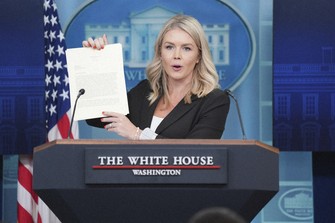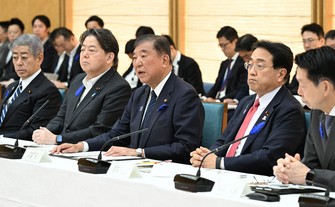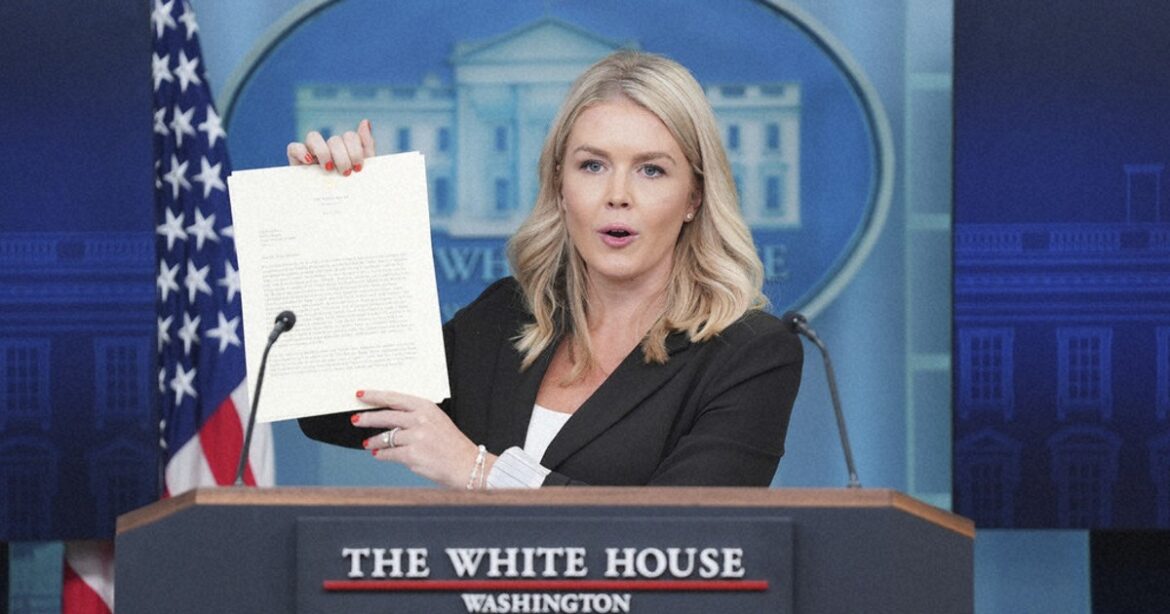
White House press secretary Karoline Leavitt speaks as she holds up a letter from President Donald Trump to Japan’s Prime Minister Shigeru Ishiba during a press briefing at the White House, July 7, 2025, in Washington. (AP Photo/Evan Vucci)
U.S. President Donald Trump has announced that the “reciprocal tariff” rate on Japan will increase to 25% from Aug. 1, higher than the previously announced 24%. Japan must not bow to U.S. pressure and should persistently negotiate for a revision of the unreasonably high tariff rate.
In April, the United States imposed a tariff rate of 10% on Japan and announced plans to defer any rate above that until July 9. While the implementation of the tariffs has been postponed, Japan has been left with less than a month for negotiations on a trade deal — an extremely short period. The aim is likely to put pressure on Japan and draw out major concessions.
All products besides automobiles and steel and aluminum products, which already face high tariffs, will be subject to the newly announced tariff rate. This could lead to a significant reduction in exports to the U.S., dealing a serious blow to the Japanese economy.
Trump has taken issue with the large trade deficit with Japan, but this argument is self-centered. He recently stated with dissatisfaction, “They won’t take our cars, and yet, we take millions and millions of their cars into the United States.” He criticized Japan’s safety standards for imported vehicles as being too strict, yet sales of European cars in Japan have risen. This is nothing more than an unfounded accusation that ignores the lack of effort by U.S. manufacturers.

Prime Minister Shigeru Ishiba, center, speaks at a meeting of the Comprehensive Response Headquarters for U.S. Tariff Measures at the prime minister’s office in Tokyo on July 8, 2025. Pictured second from right is Economic Revitalization Minister Ryosei Akazawa. (Mainichi/Akihiro Hirata)
The Trump administration, wielding its “America First” policy, is imposing reciprocal tariffs worldwide in an attempt to win favorable conditions for the U.S. While Japan has sought a review of all high tariffs, the U.S. has shown reluctance.
However, yielding to an easy compromise would leave lasting issues for Japan. Japanese Prime Minister Shigeru Ishiba’s stance of continuing to seek a review of the high tariffs to protect Japan’s national interests is only natural.
Future negotiations will coincide with the lead-up to the July 20 House of Councillors election in Japan. Some take the view it will be difficult to reach an agreement within the limited timeframe. Economic Revitalization Minister Ryosei Akazawa has frequently traveled to the United States and engaged in ministerial-level talks, and a summit between the countries’ leaders was held in June, but the gap remained unbridged.
However, one cannot say Washington’s position is strong. If high tariffs are implemented, the price of imported goods will rise. This will in turn strengthen concerns about the economy, which could reignite “sell America” sentiment in financial markets.
Japan is the largest investor in the United States. Japanese automakers have produced far more vehicles locally in the U.S. than they export to the country, and this has created jobs in the U.S.
Prime Minister Ishiba needs to emphasize the large scale of Japan’s contributions to the U.S. economy. He should exhibit strong leadership and put full effort into achieving a breakthrough in the situation.


AloJapan.com